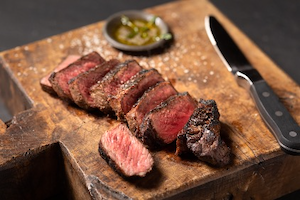
Traffic at steakhouses has surpassed its 2019 heights, well outpacing the rest of the foodservice industry according to recent data. From major chain brands with hundreds of units like Texas Roadhouse and Longhorn to smaller players like Capital Grille, Firebirds and Colton’s, it seems like everyone in steak is doing well. And it’s not just traffic – sales numbers are growing in the steakhouse segment ahead of the pace of other segments, too.
So what’s behind these meaty returns? And what can other operators take from them to their advantage? We look at three factors behind the surge, and what the smart steakhouses are doing right:
1.) Provide the ultimate dine-in experience:
Getting a great steak is just not part of the takeout or delivery wheelhouse. The service, the ambiance, the wine lists that define a steakhouse simply don’t travel, let alone that sizzling steak. For guests who have been subsisting mainly on off-premise options for the better part of two years, there’s a lot of value and “affordable luxury” in a steakhouse experience, even in a time of inflation.
2.) Serve up more than just steak:
The successful steakhouses are serving up a wider mix of proteins – including lamb, and varieties of beef from wagyu to grassfed to dry-aged. The sides and shareables are more diverse too. It’s like a wine program – you’d never serve only red wine and expect to satisfy every diner, so why limit the selection of your meats?
3.) Diversify the cuts:
Filet and ribeye is classic steakhouse fare, but it’s not always great value and doesn’t give guests a differentiated experience. Some will want to go big, with showy tomahawks for the table. Others may want a smaller portion but more variety. Less-used cuts like bavette, skirt, hanger, or sirloin strip can not only give you better margin as the operator, but also open up different service styles and invite marinades and sauces with global flavors.
Who does it well?
Gibson’s and Gibson’s Italia in Chicago tout their “World-class tour of beef, starring Gibsons Prime US Angus, Gibsons Grassfed Australian, Japanese Kobe and Miyazaki, and Carrara 640 Wagyu from Australia.”.
Hawksmoor in NYC has one of the most diverse menus you’ll see at a steakhouse, and they lean into sustainability, proudly touting their 3-star rating from the Sustainable Restaurant Association, and boldly stating “When it comes to meat: eat less, but eat better.”
Georgie by Curtis Stone in Dallas, like sister restaurant in LA, hosts a butcher shop as well as a restaurant. The menu is anchored by “butchers cuts” including coulotte and tri-tip, and from local Texas Wagyu to grassfed Australian beef and lamb.
Three cheers for success with steak! Now to go out and get your slice…

